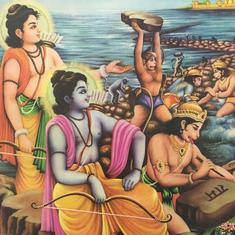All of 22, Hardik Patel exploded on Gujarat’s political horizon from nowhere some three months ago with his demand for reservations for the Patel community under the Other Backward Classes quota. His Patidar Anamat Andolan Samiti drew crowds by the thousands in rallies around the state and announced its unqualified arrival with big-bang meetings in Surat and then in Ahmedabad on August 25. Nobody, not even the ruling Bharatiya Janata Party, which counts the Patels as its key constituency, saw the maelstrom coming. Who is Hardik Patel, was the question everyone was asking.
But that was then. In just one week, the image of the indomitable youngster has taken several rounds of beatings as he has been found running through farm fields with the police on his tail, accused the police of kidnapping him, and been castigated by the Gujarat High Court for deceiving it.
Three-day drama
On Tuesday, after Hardik Patel addressed a gathering of around 2,000 people in Aravalli district, without first seeking police permission, the police swooped in. The young Patidar leader managed to escape the crackdown in his cavalcade of cars, but on finding road blockades everywhere, he decided to abandon the vehicles and scrambled on foot. “He ran like an ordinary thief,” remarked Inspector General of Police (Gandhinagar) Hasmukh Patel.
The next day, Hardik Patel appeared on a Gujarati TV channel claiming that he was “abducted by people who looked like policemen”, kept in his car overnight and then released near Dhrangadhara, about 150 kilometres away from Ahmedabad. He and his supporters have since been conveying his messages and appeals through local Gujarati television channels and the social media. There are, however, no angry public outbursts like earlier.
The setbacks did not end there. His defiant image took another hit on Thursday when the Gujarat High Court criticised him and his lawyer for taking it “for a ride” by filing a habeas corpus petition past midnight on September 22. The petition alleged that Hardik Patel was kidnapped by the police and his life was under threat.
How did a youngster who was dreaming up national ambitions within a month of launching his campaign, drawing thousands of supporters around Gujarat, suddenly become so vulnerable?
Crackdown by government
The sequence of events since September 14 – when Hardik Patel and his supporters forced Gujarat Chief Minister Anandiben Patel to hold parleys on their demands – holds the clues to the agitation’s decline.
At the meeting, instead of talking of his agitation, Hardik Patel demanded action against 4,200 policemen who he said had unleashed violence following his Ahmedabad rally, leaving 12 dead. Not just this, he also wanted Minister of State for Home Rajnikant Patel punished. Anandiben Patel, 75, who by then had been brought to her knees by the agitators, sought 10 days to resolve the demands. (The ultimatum got over on Thursday – but the state is yet to yield.)
The first rule that Hardik Patel broke after the negotiations was to put back on track his plans for a “reverse Dandi yatra” on September 19 which he had deferred after the state’s invitation for talks. An irate government clamped Section 144 of the Criminal Procedure Code, preventing assembly of more than four people, at all places he or his supporters planned to meet. Strict instructions went out from the chief minister’s office to crush the agitation.
Affecting defiance, Hardik Patel announced that the “reverse Dandi yatra”, renamed Ekta Yatra, would go ahead as planned on September 19 even if his group had to court arrest. But when the moment arrived, he couldn’t muster the gumption – not only because of state threats, but more significantly because a newly-formed OBC Ekta Manch, backed by Dalits and Adivasis, had promised to resist the Patidars with a counter-rally.
Hardik Patel kept on changing the venue for the yatra till the eleventh hour and finally picked a Sardar Patel square in Surat’s Patel-dominated Varachha area. Most residents of this neighbourhood are Patels from the Saurashtra region who were attracted to Surat by its diamond trade. However, on September 19, even in Varachha, just 50 people turned up. Hardik Patel and 30 others were detained by the police after the meeting and released later that night.
Significantly, there was no violence after the detentions, in contrast to the aftermath of the August 25 rally.
Special measures for the poor
While acting tough on the Patidar agitators, the Anandiben Patel government has also ensured that there’s no Patel reaction, especially in view of the elections to 300 local bodies. These include the eight municipal corporations controlled by the Bharatiya Janata Party, in Ahmedabad, Vadodara, Rajkot, Surat, Rajkot, Bhavnagar, Junagadh and Gandhinagar.
Equally significantly, the Cabinet discussed on Wednesday the counsel of a seven-member committee, headed by Health Minister Nitin Patel, that recommends granting reservations to economically weaker sections, setting up autonomous development boards for these sections, and providing scholarships for meritorious students in self-finance medical and engineering colleges. The Anandiben Patel government is also considering raising the upper age limit for candidates of non-reserved categories in posts that are lying vacant for a long time, and running free coaching classes to prepare students of economically weaker sections for competitive examinations, irrespective of their caste.
This came after the Rajasthan assembly approved reservations for the poor among upper castes and Rashtriya Swayamsevak Sangh chief Mohan Bhagwat demanded a review of the country’s reservation policy.
According to official sources, the government is expected to make an announcement about the new measures in about a week, before the notification for the municipal corporation elections goes out. Whenever they come through, they are likely to take the fizz out of Hardik’s agitation – whatever is left of it.










